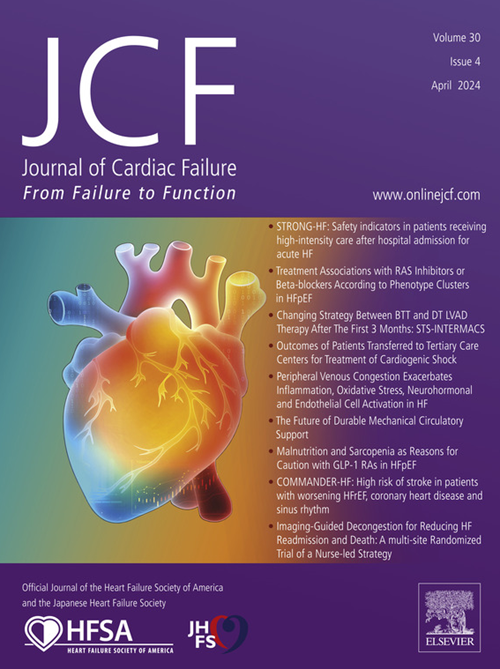Safety and Feasibility of an Implanted Inferior Vena Cava Sensor for Accurate Volume Assessment: FUTURE-HF2 Trial
IF 6.7
2区 医学
Q1 CARDIAC & CARDIOVASCULAR SYSTEMS
引用次数: 0
Abstract
Background
A novel implantable sensor has been designed to measure the inferior vena cava (IVC) area accurately so as to allow daily monitoring of the IVC area and collapse to predict congestion in heart failure (HF).
Methods
A prospective, multicenter, single-arm, Early Feasibility Study enrolled 15 patients with HF (irrespective of ejection fraction) and with an HF event in the previous 12 months, an elevated NT-proBNP level, and receiving ≥ 40 mg of furosemide equivalent. Primary endpoints included successful deployment without procedure-related (30 days) or sensor-related complications (3 months) and successful data transmission to a secure database (3 months). Accuracy of sensor-derived IVC area, patient adherence, NYHA classification, and KCCQ were assessed from baseline to 3 months. Patient-specific signal alterations were correlated with clinical presentation to guide interventions.
Results
Fifteen patients underwent implantation: 66 ± 12 years; 47% female; 27% with HFpEF, NT-ProBNP levels 2569 (median, IQR: 1674–5187, ng/L; 87% NYHA class III). All patients met the primary safety and effectiveness endpoints. Sensor-derived IVC areas showed excellent agreement with concurrent computed tomography (R2 = 0.99, mean absolute error = 11.15 mm2). Median adherence to daily readings was 98% (IQR: 86%–100%) per patient-month. A significant improvement was seen in NYHA class and a nonsignificant improvement was observed in KCCQ.
Conclusions
Implantation of a novel IVC sensor (FIRE1) was feasible, uncomplicated and safe. Sensor outputs aligned with clinical presentations and improvements in clinical outcomes. Future investigation to establish the IVC sensor remote management of HF is strongly warranted.
植入式下腔静脉传感器用于精确容量评估的安全性和可行性:FUTURE-HF2 试验。
背景:设计了一种新型植入式传感器来精确测量下腔静脉(IVC)面积,以便每天监测IVC面积和塌陷情况,预测心力衰竭(HF)的充血情况:一项前瞻性、多中心、单臂、早期可行性研究招募了 15 名在过去 12 个月内发生过心衰事件、NT-proBNP 升高、服用呋塞米等效剂量≥40 毫克的心衰患者(不考虑射血分数)。主要终点包括成功部署,无手术相关并发症(30 天)或传感器相关并发症(3 个月),以及成功将数据传输到安全数据库(3 个月)。从基线到三个月期间,对传感器得出的 IVC 面积、患者依从性、NYHA 分级和 KCCQ 的准确性进行了评估。患者特异性信号改变与临床表现相关联,以指导干预措施:15 名患者接受了植入手术(66±12 岁;47% 女性;27% HFpEF,NT-ProBNP 2569(中位数,IQR:(1674-5187) ng/L;87% NYHA III 级)。所有患者均达到了主要安全性和有效性终点。传感器得出的 IVC 面积与同时进行的 CT 显示出极好的一致性(R2=0.99,平均绝对误差=11.15 mm2)。患者月每日读数的坚持率中位数为 98%(IQR:86-100%)。NYHA分级有明显改善,KCCQ无明显改善:结论:植入新型 IVC 传感器 (FIRE1) 是可行、简便和安全的。传感器的输出结果与临床表现和临床结果的改善相一致。今后,有必要对 IVC 传感器对高血压的远程管理进行研究。
本文章由计算机程序翻译,如有差异,请以英文原文为准。
求助全文
约1分钟内获得全文
求助全文
来源期刊

Journal of Cardiac Failure
医学-心血管系统
CiteScore
7.80
自引率
8.30%
发文量
653
审稿时长
21 days
期刊介绍:
Journal of Cardiac Failure publishes original, peer-reviewed communications of scientific excellence and review articles on clinical research, basic human studies, animal studies, and bench research with potential clinical applications to heart failure - pathogenesis, etiology, epidemiology, pathophysiological mechanisms, assessment, prevention, and treatment.
 求助内容:
求助内容: 应助结果提醒方式:
应助结果提醒方式:


